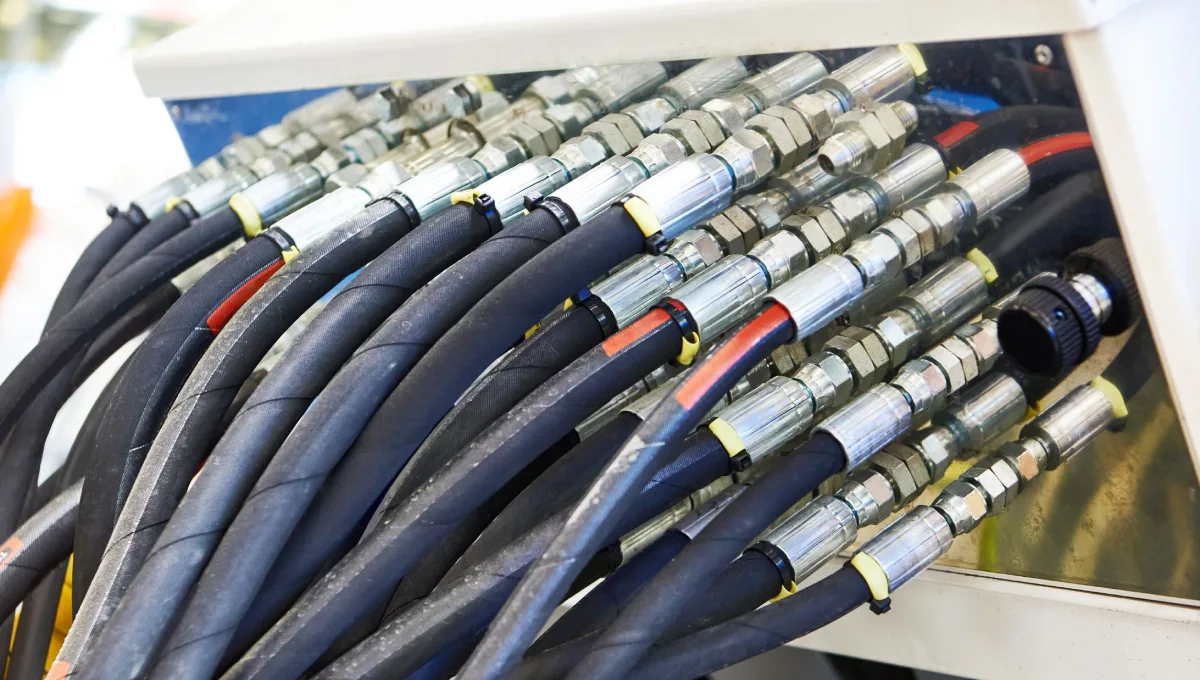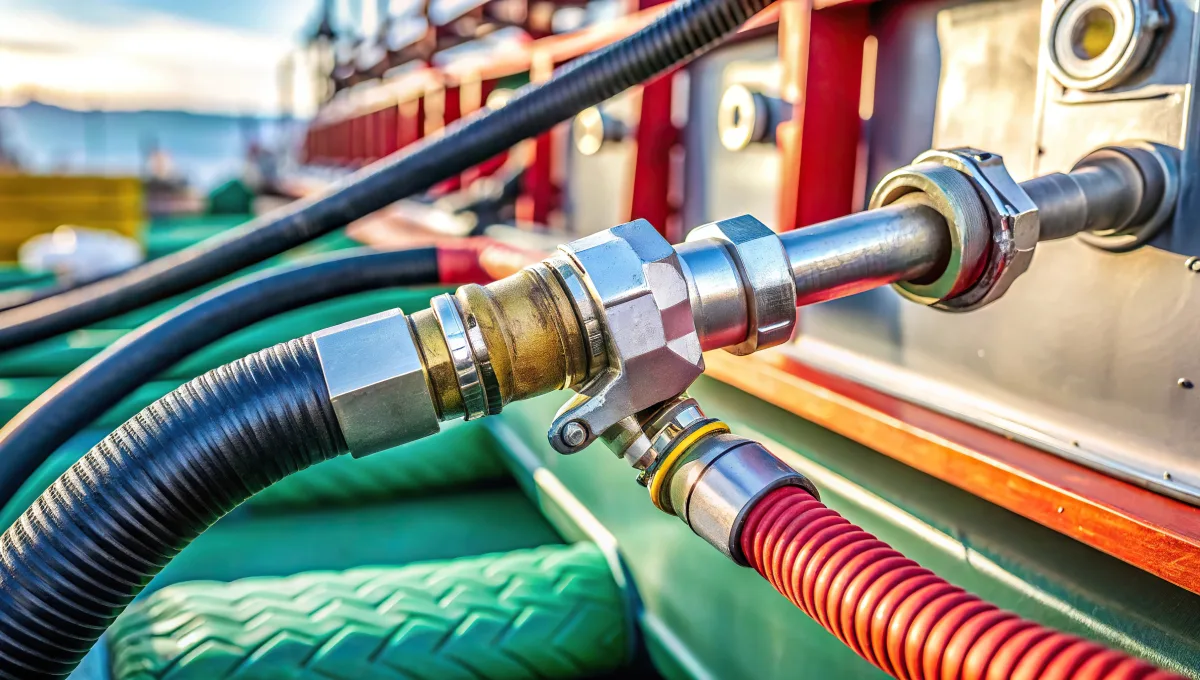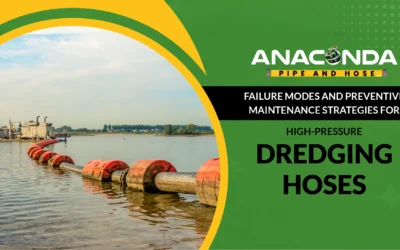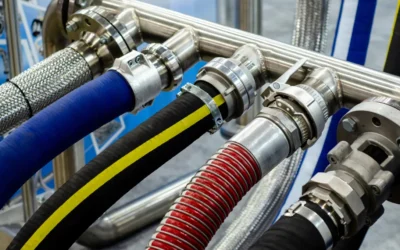- Introduction
- What Are Industrial Fuel Hoses?
- Why Fuel Hose Standards Matter
- Overview of Global Fuel Hose Standards and Regulations
- Key Performance Criteria for Fuel Hose Compliance
- Labeling, Certification, and Traceability
- Selecting the Right Fuel Hose for Your Application
- Fuel Hose Testing, Inspection, and Maintenance
- Compliance Pitfalls to Avoid
- Conclusion
Introduction
An industrial fuel hose plays a vital role in fluid transfer operations across critical sectors such as construction, mining, oil and gas, marine, and aviation. These hoses are engineered to handle the safe transfer of flammable and volatile fuels, including diesel, gasoline, biodiesel, and kerosene. Whether used on a mobile fuel hose roller industrial system or in a fixed fueling setup, their performance directly impacts operational safety, fuel efficiency, and compliance with industry regulations.
Selecting the right industrial hose is not just a matter of convenience. It’s a critical decision that influences equipment longevity and environmental protection. Non-compliance with current standards for industrial fuel hose systems can lead to hazardous fuel leaks, fires, environmental damage, regulatory penalties, and unexpected downtime. The financial and reputational costs of such incidents make adherence to fuel hose standards a top priority for any operation handling combustible fluids.
With evolving fuel types and increasingly stringent global standards, understanding compliance requirements has never been more essential. This guide explores what defines a compliant fuel hose, the key regulations to know, and best practices for ensuring your hoses are safe, certified, and up to date with industry expectations.

What Are Industrial Fuel Hoses?
An industrial fuel hose is a specially engineered flexible tube designed for transferring petroleum-based liquids safely and efficiently. These hoses are essential in various settings, including fuel distribution networks, bulk fuel storage facilities, generator installations, refueling stations, ship-to-shore operations, and remote field equipment. Whether deployed on a fuel hose roller industrial unit or installed as part of a stationary fuel transfer system, they are built to endure harsh operating conditions.
Industrial fuel hoses are typically connected to pumps, storage tanks, delivery nozzles, or fuel trucks. They are constructed to handle hydrocarbon-based fluids under a wide range of temperatures and pressures while resisting environmental wear.
Types of Fluids Transported
- Diesel fuel
- Gasoline (petrol)
- Biodiesel
- Kerosene
- Jet fuels (e.g., Jet A, JP-8)
- Ethanol blends
Due to the chemical volatility of these fluids, industrial fuel hose systems must resist swelling, degradation, and leaks over extended periods of use.
Key Materials Used
- Nitrile rubber – Exceptional resistance to fuel and oil
- PVC – Lightweight and flexible
- Neoprene – Abrasion- and weather-resistant
- Composite materials – Multi-layered construction for high-pressure and chemical resistance
Each industrial hose is selected based on application-specific fuel types, environmental exposure, and pressure demands.
Why Fuel Hose Standards Matter
The importance of fuel hose standards cannot be overstated. An industrial fuel hose is responsible for safely transferring flammable liquids in high-risk environments. When hoses fail to meet industry standards, the consequences can be severe and costly.
Risks of Non-Compliant Hoses
Using substandard or incorrectly specified hoses can result in:
- Hazardous fuel leaks and spills
- Fire outbreaks or explosions
- Regulatory fines from environmental agencies
- Operational delays and unscheduled downtime
- Damage to machinery and loss of valuable fuel
These risks escalate dramatically in harsh or high-pressure conditions. A poorly maintained or incompatible industrial hose can quickly become a liability, endangering personnel and operations.
Ensuring Safe Fuel Transfer
Compliance standards provide essential benchmarks for hose strength, chemical resistance, temperature tolerance, and safe electrical conductivity. A certified industrial fuel hose ensures the system can endure the mechanical stress and environmental exposures common in fuel transfer operations, whether stationary or mobile.
Critical in High-Risk Environments
In volatile settings like offshore platforms, refineries, and aviation fueling stations, hose failures can lead to catastrophic incidents. Integrating compliant hoses with systems such as a fuel hose roller industrial setup not only improves operational efficiency but also reinforces safety protocols, making compliance a non-negotiable requirement.
Overview of Global Fuel Hose Standards and Regulations
Understanding the standards that govern industrial fuel hose manufacturing and usage is essential for global compliance and operational safety. These standards ensure that hoses meet critical performance criteria for strength, temperature tolerance, and chemical resistance across various industries.
SAE Standards (U.S.)
The Society of Automotive Engineers (SAE) provides detailed classifications for fuel hose construction and performance:
- SAE J30: Primarily used in automotive fuel lines.
- SAE J1527: Governs marine fuel hoses for recreational and commercial vessels.
- SAE J1942: Applies to marine and inland waterway vessel fuel hoses.
These standards are crucial when selecting an industrial hose for regulated environments like transport and marine applications.
ISO Standards
The International Organization for Standardization (ISO) offers global frameworks such as:
- ISO 7840: Fire-resistant marine fuel hoses.
- ISO 1825: Hoses used in aviation refueling.
- ISO 1307: General hose dimensions and tolerance requirements.
These standards help ensure industrial fuel hose compatibility across international systems and supply chains.
EN/BS (Europe and UK)
- EN 1360: For rubber and thermoplastic fuel dispensing hoses.
- BS 1435-1: Focused on hydrocarbon fuel hose safety.
Other Region-Specific Codes
- API specs: Common in U.S. refineries.
- CSA & AS/NZS: Address Canadian and Australian needs, including mobile applications like fuel hose roller industrial systems.

Key Performance Criteria for Fuel Hose Compliance
To ensure safety and reliability, every industrial fuel hose must meet specific performance benchmarks. These criteria are set by global standards and tested through rigorous quality control procedures.
Pressure Ratings and Burst Pressure
A compliant fuel hose must be clearly rated for both working pressure and burst pressure.
- Working Pressure: The maximum pressure expected during regular operations.
- Burst Pressure: Typically four times the working pressure to provide a safety margin.
Routine testing is vital to prevent ruptures in high-pressure systems, such as those mounted on a fuel hose roller industrial system.
Temperature Range
Industrial fuel hoses must endure extreme temperature conditions:
- In hot climates, hoses must resist softening and bursting.
- In cold environments, they must remain flexible and crack-resistant.
Some applications also require flame resistance and self-extinguishing properties.
Permeation Resistance
Low-permeation hoses reduce:
- Volatile organic compound (VOC) emissions
- Fuel evaporation and product loss
- Exposure to toxic vapors
Electrical Conductivity and Anti-Static Protection
To avoid static discharge, industrial hose assemblies include conductive elements and often require grounding, especially in marine and aviation applications.
Chemical Compatibility
Fuel types like ethanol and biodiesel can degrade unsuitable materials. Selecting the right industrial fuel hose based on compatibility charts is critical for long-term reliability.
Labeling, Certification, and Traceability
Clear labeling and third-party certification are critical components of a compliant industrial fuel hose. Properly marked hoses ensure that end users can quickly verify a hose’s capabilities and compliance with industry standards.
A certified hose should clearly display:
- Manufacturer name or logo
- Date code or batch number for production tracking
- Working pressure and temperature range
- Applicable compliance markings such as SAE J30 R9, ISO 7840, or EN 1360
These markings provide essential details for ensuring correct application and safe operation. For mobile systems such as those using a fuel hose roller industrial setup, proper labeling helps operators confirm that the hose is suitable for on-site conditions.
Independent certification from recognized bodies like UL (Underwriters Laboratories), FM Global, or CE is vital. These certifications confirm that the industrial fuel hose has passed rigorous testing and adheres to international safety and quality standards.
Traceability is another key element in regulatory compliance and operational safety. It allows users to:
- Conduct faster and more effective audits
- Plan preventive maintenance
- Perform accurate root cause analysis in the event of a hose failure
Using a properly labeled and certified industrial hose improves accountability and minimizes the risk of costly incidents due to hose misapplication or failure.
Selecting the Right Fuel Hose for Your Application
Choosing the correct industrial fuel hose is essential for ensuring safety, durability, and operational efficiency. The specific demands of your industry and application environment should guide selection.
Industry Considerations
- Construction & Mining: Requires abrasion-resistant and rugged hoses capable of handling rough terrain and debris.
- Marine & Offshore: Demands saltwater-resistant hoses with anti-static properties for safe fuel transfer in corrosive environments.
- Military: Must comply with MIL-specs, be weather-resistant, and function reliably in extreme temperatures.
- Aviation: Needs hoses with flame resistance, low-permeation ratings, and precise fuel compatibility.
Flexible vs. Rigid Hoses
- Flexible Hoses: Ideal for mobile equipment or use with a fuel hose roller industrial setup due to their ease of handling.
- Rigid (Hard-Wall) Hoses: Suitable for high-suction or high-pressure applications where structural integrity is crucial.
Coupling and Attachment Standards
A compliant industrial hose is only as reliable as its couplings.
Ensure that fittings are:
- Corrosion-resistant
- Properly crimped or clamped
- Rated to match hose pressure specifications
Lifespan Evaluation
The service life of an industrial fuel hose depends on factors such as exposure to UV radiation, chemical degradation, and frequency of use. Manufacturers typically provide maintenance guidelines and replacement schedules based on lab and field testing.

Fuel Hose Testing, Inspection, and Maintenance
To maintain operational safety and avoid costly downtime, regular testing and inspection of your industrial fuel hose is critical. These procedures help detect early signs of wear or failure, ensuring your fuel system remains reliable in demanding conditions.
Routine Inspection Checkpoints
Operators should perform visual inspections during routine maintenance. Key indicators of hose degradation include:
- Cracking along the outer cover or inner lining
- Bulging or swelling at pressure points
- Soft spots or blistering caused by internal delamination
- Corrosion or slippage at the hose fittings and couplings
For mobile systems like those using a fuel hose roller industrial configuration, daily pre-use inspections are highly recommended to catch signs of stress from frequent deployment and retraction.
Testing Protocols
Comprehensive testing ensures the industrial hose remains within safe operational limits:
- Hydrostatic Testing: Pressurizes the hose with water to check for structural leaks or weaknesses.
- Vacuum and Leak-Down Tests: Detect microleaks in suction systems or high-vacuum environments.
- Conductivity Testing: Verifies the hose’s ability to dissipate static electricity, which is essential for flammable fuel transfer.
Maintenance Best Practices
- Replace proactively, not after failure.
- Maintain detailed logs of inspections, tests, and replacements.
- Implement standard operating procedures (SOPs) for responding to hose failure incidents and potential fuel spills to limit risks and ensure regulatory compliance.
Staying proactive with industrial fuel hose maintenance ensures performance and safety across all operations.
Compliance Pitfalls to Avoid
Maintaining compliance with fuel hose standards requires more than just initial product selection. It demands ongoing diligence. Even experienced operators can unknowingly introduce risks by overlooking key details related to their industrial fuel hose systems.
Using the Wrong Hose Type
One of the most common mistakes is using general-purpose hoses for fuel transfer. These hoses are not built to handle the chemical aggressiveness or pressure demands of hydrocarbon fuels. A non-compliant industrial hose can rapidly deteriorate, leading to fuel leaks or catastrophic failures.
Ignoring Fuel Compatibility
As fuel formulations evolve, so should your hose material selection. Ethanol, biodiesel, and methanol are more chemically aggressive than traditional fuels. An industrial fuel hose not rated for these modern blends can degrade internally, swell, or even delaminate—especially under pressure or temperature fluctuations.
Skipping Documentation
Lack of proper documentation is a hidden but serious compliance risk. Maintenance logs, test records, and certification details are essential during inspections and insurance claims. Without them, proving due diligence becomes difficult.
This is particularly important in mobile systems like those using a fuel hose roller industrial setup, where hoses are subjected to more frequent movement and wear. Keeping organized records and staying updated on evolving standards is key to ensuring both safety and legal compliance.
Conclusion
In today’s safety-critical industrial landscape, strict adherence to industrial fuel hose standards is not just about meeting regulatory requirements—it’s about protecting your workforce, equipment, and bottom line. Every stage of the hose lifecycle, from material selection and compatibility to certification and routine inspections, contributes to safer and more reliable fuel handling operations.
Utilizing the proper industrial hose tailored to your specific fuel type and operating environment greatly reduces the risk of leaks, system failure, or environmental incidents. This is especially true for dynamic fueling setups, such as those mounted on a fuel hose roller industrial unit, where frequent deployment and retraction demand exceptional durability and ongoing maintenance.
Equally important is working with a trusted, certified supplier who understands global standards like SAE, ISO, and EN. Staying informed about compliance updates and maintaining detailed documentation on testing and inspections ensures that your operations are always audit-ready.
Ultimately, investing in a certified industrial fuel hose system is a proactive measure that reinforces safety, boosts efficiency, and minimizes costly downtime. Don’t wait for a compliance issue or equipment failure to take action—be strategic, stay compliant, and fuel your operations with confidence.






0 Comments